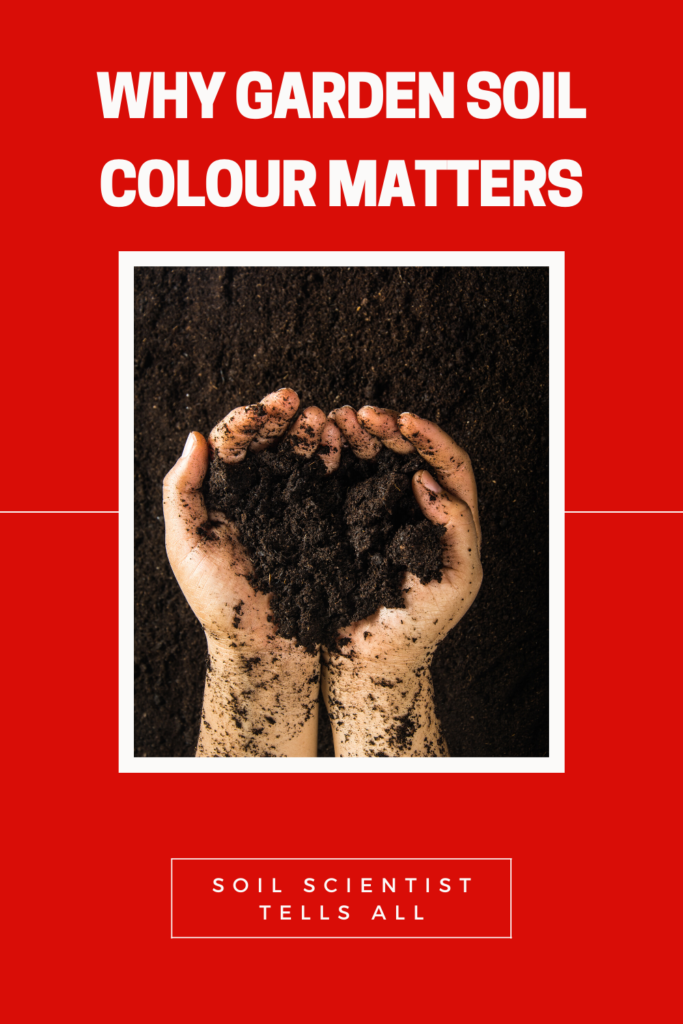- Canada’s Growing Zones Are Changing 2024 - January 12, 2024
- Attracting Wildlife To The Garden - May 16, 2023
- How To Garden Near A Septic Tank - May 9, 2023
Soil colour testing in garden soils can tell us a historical story about your soil. The colour of soil matters because it helps us determine the source of our formation, hydrological patterns & horizon thickness. This Gardening In Canada article is going to be looking at how soil colour in your garden tells us a story.
If you are new to this blog my name is Ashley and I am a soil scientist. I am located in a Canadian Zone 3 and a USDA Zone 4. I write articles, make YouTube videos, Instagram & Facebook posts all designed for Canadians and Cold Climate gardeners using science-based methods. If you are looking for anything specific be sure to let me know in the comments down below.

What Does Garden Soil Colour Tell Us?
Colour or lack of colour, tells us a story about the environment we are providing to our soil via watering, also the inputs and outputs. Examples of alleviated soil are waterlogged soils that turn aerobic bacteria into anaerobic bacteria. Anaerobic bacteria utilize Ferric Iron (Fe3+) as the electron receptor for their metabolism. This results in a byproduct of Ferrous Iron (Fe2+) that is both colourless and water-soluble. The Ferrous Iron when returned to the soil makes grey soil. This will show as a horizon or even as a stripping/patchy grey area.
Soil Scientists use a formal document called the Munsell System. This system has three colour components to match: Hue (the main colour), Value (lightness or darkness), Chroma (Intensity). Unfortunately, the book that has the Munsell colour system inside is around $250 Canadian. So we will be using our next best thing common sense.
If you were looking to use the Munsel system version I put together in my book feel free to check out my printable or paperback. Inside I do have a colour chart that will allow you to match your soil accordingly.

How To Do A Soil Colour Testing For Garden Soil
- Dig a soil profile to expose your soil horizons. To learn more about soil profiles and how to dig them check out my article here.
- Place toothpicks where you notice a change in soil colour.
- Use the below guide to help determine colour and cause
This will help you research the best course of action for improving your garden soil. Soil colour testing is the key to determining water and nutrient movement in your garden.
Black Garden Soil
If you have black content in your soil it is an indication of high organic material. If you have black content in your soil it is an indication of high organic material. The black material is often found in the O horizon and A horizon of our soil. Black soil content is an indication of highly productive soils in most cases. This garden soil colour is often referred to this as “black gold”.
But keep in mind that all soil is on a spectrum and some common sense is needed. If you’re noticing squishy black undigested material this is an indication of organic soil. I don’t mean this as organic fertilizer but rather as the soil type.
Black garden soil is not necessarily a good thing because of an indication of high levels of soil moisture. this black substance can also be an indication of heavy clay soils. The soil texture test is another option to help determine the true nature.
Red Garden Soil
In the article about soil profiles, we spoke about flex or lines of red. But what about if your entire soil is red in colour what does this mean. Red soils are often deficient and nutrients needed by our plants. Some of the key nutrients missing in red soils include zinc, sulphur, phosphorus and even nitrogen. If you watch the series on YouTube about the 17 essential plant nutrients you know how much of an issue this is.
Red soils are considered old soils and that means that they have been exposed to heavy rates of weathering.
Lighter Coloured or White Garden Soil
Lighter coloured soils that appear to be gray or white in nature are a sign of heavy sand content. this means really good drainage but sometimes too good of drainage. The appearance of lightly coloured soil is generally a sign of potential nutrient deficiencies. Things that may be missing from the soil can include the macronutrients such as nitrogen, potassium and phosphorus but also some micronutrients such as iron.
Blue Gray Garden Soil
If you’re noticing your soil is blue or a blue-gray colour and has a bad odour similar to that of sulphur you may have poorly aerated soil. This is a sign that the organic material that’s trying to decompose in your soil is doing so without oxygen. These soils do not have access to oxygen to break down the material and therefore it tends to get a bit smelly. This lack of oxygen combined with poor decomposition can change our soil colour to a blue-gray muck. To reclaim these wheels you may want to consider aerators or the use of a Rototiller.
Feel free to send over your photos of soil colour. I’d be interested to see what types of soil colours you have and what your plans are to make the ultimate garden soil.

